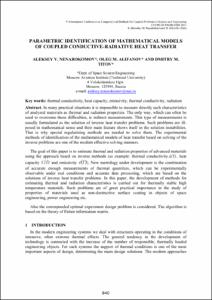Parametric identification of mathematical models of coupled conductive-radiative heat transfer

Estadístiques de LA Referencia / Recolecta
Inclou dades d'ús des de 2022
Cita com:
hdl:2117/192632
Tipus de documentText en actes de congrés
Data publicació2013
EditorCIMNE
Condicions d'accésAccés obert
Tots els drets reservats. Aquesta obra està protegida pels drets de propietat intel·lectual i
industrial corresponents. Sense perjudici de les exempcions legals existents, queda prohibida la seva
reproducció, distribució, comunicació pública o transformació sense l'autorització del titular dels drets
Abstract
In many practical situations it is impossible to measure directly such characteristics
of analyzed materials as thermal and radiation properties. The only way, which can often be
used to overcome these difficulties, is indirect measurements. This type of measurements is
usually formulated as the solution of inverse heat transfer problems. Such problems are illposed
in mathematical sense and their main feature shows itself in the solution instabilities.
That is why special regularizing methods are needed to solve them. The experimental
methods of identification of the mathematical models of heat transfer based on solving of the
inverse problems are one of the modern effective solving manners.
The goal of this paper is to estimate thermal and radiation properties of advanced materials
using the approach based on inverse methods (as example: thermal conductivityλ(T) , heat
capacity C(T) and emissivity ε (T )). New metrology under development is the combination
of accurate enough measurements of thermal quantities, which can be experimentally
observable under real conditions and accurate data processing, which are based on the
solutions of inverse heat transfer problems. In this paper, the development of methods for
estimating thermal and radiation characteristics is carried out for thermally stable high
temperature materials. Such problems are of great practical importance in the study of
properties of materials used as non-destructive surface coating in objects of space
engineering, power engineering etc.
Also the corresponded optimal experiment design problem is considered. The algorithm is
based on the theory of Fisher information matrix.
ISBN978-84-941407-6-1
| Fitxers | Descripció | Mida | Format | Visualitza |
|---|---|---|---|---|
| Coupled-2013-74 ... cation of mathematical.pdf | 515,0Kb | Visualitza/Obre |

